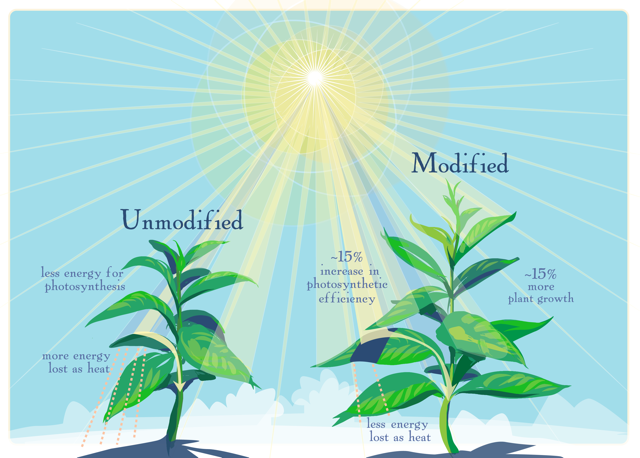While genetically modified crops have achieved significant environmental benefits, decreased insecticide use and boosted profits for farmers in adopting countries, critics counter that they have failed to deliver on promises of increasing yield.
The New York Times recently published a long piece highlighting these criticisms, claiming that its investigations had found “no discernible advantage in yields” from the adoption of genetically modified crops.
As if to answer this challenge, a scientific team funded by the Bill & Melinda Gates Foundation published a paper in the journal Science, revealing the initial promising results of its efforts to boost yields by improving the efficiency of plant photosynthesis. The first field trials of these transgenic crops showed productivity increases ranging from 14 to 30 percent.
The US-based team hopes to be able to next replicate this success in food crops that are important staples in developing countries, such as rice, cassava and the African legume cowpea, with proof of concept in these crops within as little as a year.
In a London interview with the Cornell Alliance for Science, research leader Stephen Long was cautiously optimistic about the long-term prospects of the Realizing Improved Photosynthetic Efficiency (RIPE) project to help poorer farmers.

“Having an impact on farmers, particularly in the poorest parts of the world, is very important to myself and my group, Long said. We’ve devoted quite a chunk of our lives to this, in the hope that this is going to provide germplasm seed that farmers in these countries can really benefit from.”
If a step-change in productivity can be delivered to farmers in developing countries, this can translate to a big improvement in livelihoods and a reduction in poverty, Long told the Alliance for Science.
“In terms of the livelihoods of farmers in these countries and often these farms are very small, one acre is not uncommon being able to improve the yield on that land can make a very big difference to their livelihoods, Long said. So for example, they may be producing just enough food for their family. If we can provide them with germplasm which gives them 30 percent more, they have enough for their family and now some to sell, to pay for other services like education for their children.”
The team is focusing on photosynthetic efficiency because it is potentially a sustainable response to the challenges of maintaining agricultural productivity in the face of climate change. It could also address the widely acknowledged need to increase total world food production by at least 70 percent by 2050 to feed a rising population without expanding cultivated land area and thereby destroying the remaining rainforests.
“We need to get yield increases without using more water, without using more nitrogen,” Long emphasized.
The researchers used computer simulations to identify which of the 140 key steps in the photosynthesis chain might be most suitable for genetic tweaking to improve efficiency. They settled on a process called non-photochemical quenching of chlorophyll florescence, whereby the plant typically responds only slowly to changes in light intensity.
Top leaves in full sunlight typically receive more photons than they can cope with, preventing damage from being done to sensitive parts of the leaf by converting some of the received light energy to heat. However, when a cloud obscures the sun, the time-lag in relaxing this quenching effect wastes valuable light energy that could be used to improve carbon-fixation, and thereby the biological productivity of the plant.
Long and his colleagues focused on speeding up the response time to changing light conditions by inserting genes from a model plant frequently used by scientists, the mustard relative Arabidopsis, into the easy-to-transform model plant tobacco. These genes cause the plant to over-express certain proteins already ubiquitous in the plant kingdom that help it to respond more quickly to changes in light intensity.
When tested in field trials, transgenic tobacco plants with the additional genes showed an increase in total biomass of 14 to 20 percent relative to non-transgenic control plants. Researchers are now moving forward to determine whether these genetic manipulations can lead to more consumable yield in food crops.
Long also noted that under the Bill & Melinda Gates Foundation s global access commitments, any new higher-yielding crops will be made available to farmers in developing countries at an affordable price, despite the intellectual property rights generated.
